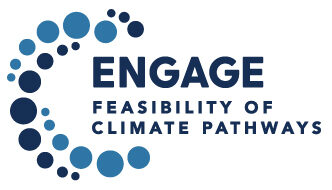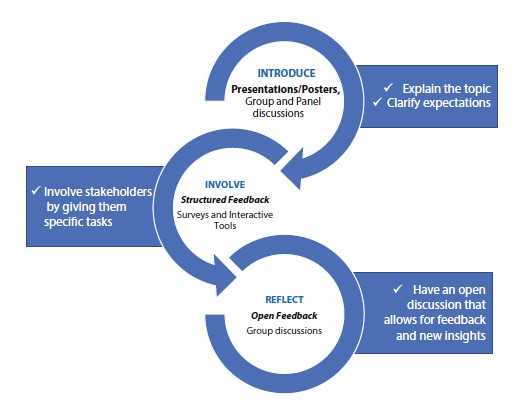
Policy Brief #42, October 2023. Workshops bringing scientists together with stakeholders from various backgrounds have shown the importance of dialogue for co-designing climate pathways and highlighted the need for physical meetings and capacity building.
To find and implement solutions to climate change and other complex problems that society faces, requires constructive dialogue between the research community and a wide range of other stakeholders. Since 2019, the ENGAGE project has developed and used a carefully designed stakeholder engagement process to co-design climate mitigation pathways through open discussions about a range of topics using a combination of surveys, visual tools, and presentations.
The project has confirmed that a process of dialogue is vital for designing impactful climate policy. Some of the most salient lessons are:
- Online activities cannot fully replace physical meetings.
- Capacity building is essential to increase the facilitation skills of partners and scientific understanding among other stakeholders.
- A central platform is needed to document lessons learned in stakeholder engagement across projects.
Engaging to meet the challenge
Climate change is an extremely complex challenge, requiring transformative changes in society. Experience has demonstrated that this requires a process of iterative and constructive dialogue between the research community and a wide range of other stakeholders from governments, non-governmental organizations, businesses, financial institutions, industry, international organizations, and civil society. Such a process can enhance the use of local and specialized knowledge in research, and also support buy-in, as people are more willing to accept results and insights if they are part of the process. Stakeholder involvement has become a key element of EU policy development in order to enable stakeholders to express their view over the entire lifecycle of a policy. It is also recognized as a key component of responsible research and innovation.
An important element of good practice in stakeholder engagement is skilled facilitation that opens a safe space for participants to discuss complex or emotional issues in an open way. This encourages a deeper connection between the participants and the emergence of new, creative ideas. An approach known as the Art of Hosting serves these objectives, using processes such as informal interactions to help make people feel comfortable, and was used for designing stakeholder engagement in the ENGAGE project.
There were two streams of stakeholder engagement:
(i) stakeholder co-design and assessment of global decarbonization pathways; and
(ii) stakeholder dialogues on national and regional policies and pathways.
Nine workshops were held: three at the global level and six at the national and regional level (Figure 1). The first five workshops were held online due to the COVID-19 pandemic. The last four were physical meetings.
The process in each was split into introduce, involve, reflect: A variety of tools and approaches (Figure 2) was used to introduce topics to stakeholders, especially presentations on model results, panel discussions, and storytelling; and in two workshops, posters.
Prominent speakers were invited for introductory presentations.
Then, to involve stakeholders in the work, the project used surveys and interactive tools pertaining to key concepts or model results to collect structured feedback from all stakeholders.
Finally, moderated discussions in small groups provided an open space to reflect, to collect more general feedback, and provide new insights.
Figure 2: Various forms of engagement used in the workshops.
For example, a workshop might begin with a brief presentation on model results, showing a set of possible scenarios that limit warming to 2°C. Then, an online tool combined with a survey of the participants might be used to assess the feasibility of the scenarios. While the stakeholders might respond that some scenarios are feasible, they might also find that others are infeasible, perhaps due to technological constraints or lack of governance mechanisms. This process contributes to the co-design of emissions scenarios as stakeholders provide their perspectives, which can be taken up by researchers.
After each workshop, evaluation by the project team played an important role in improving tools and approaches. While the team succeeded in most cases to stimulate a two-way dialogue with stakeholders, they also learned that some changes to the interactive tools were necessary. For example, it was found that the first version of the feasibility tool was too complex to be grasped in the limited time available, so it was simplified for later online workshops.
Combining approaches and tools brought added value. In particular, linking surveys, visual tools, presentations, and open discussion worked well, and provided valuable insights for stakeholders and the project team.
One insight was that participants believed that social movements, finance, and political leadership could have a strong impact on decarbonization. This led to the ENGAGE project paying more attention to social dimensions in its work on decarbonization pathways. Stakeholders also highlighted the need to consider the role of institutions in determining the feasibility of decarbonization, and this was taken up in subsequent work in the ENGAGE project.
The need for physical meetings
The team’s experience in this project shows that online activities cannot completely replace physical meetings for effective co-creation of decarbonization pathways – or, more generally, to find solutions to the complex problems of unsustainability.
Online dialogues have one major disadvantage: the need to keep them short. The project determined that online meetings had to be kept to no more than two hours, or a large proportion of participants would leave early. As a result, there is little or no time for participant introductions, and no opportunity to get to know other
participants in informal group activities. Nor is there enough time in breakout groups to cover more than one
or two key questions or to engage in in-depth discussion. There is also no time for a feedback-round and workshop evaluation at the end of the session.
To find and implement pathways that meet the Paris goals, stakeholders need enough time and space to get to know and understand diverse perspectives, to dive deep where necessary, and to engage in multiple, iterative dialogues. An open knowledge system to find solutions for problems of unsustainability can be supported by online meetings, but also needs longer physical meetings that are part of a longer-term social learning process.
Capacity building
A co-creation process depends on the willingness of the project management team and partners to invest time and resources in the activities throughout the course of the project. The project coordinator therefore needs to fully understand the importance and value of a two-way dialogue, the steps that need to be taken, and their role in the process, as well as nurturing this understanding from all project partners by capacity building on the one hand and being a role model on the other.
This requires continuous capacity building for partners, teaching them the art of facilitation – such as how to pose questions, take care of a breakout group, and report succinctly. Within the ENGAGE project, a capacity building workshop was held early in the project in collaboration with the NEW HORRIZON project. This was mainly for students rather than project partners, but it provided a template for an effective capacity-building initiative, following the Art of Hosting approach.
The project also showed a need for capacity building for other stakeholders. Participants in several workshops wanted to learn more about how integrated assessment models work and how to interpret the results. In addition, the process needs to inform stakeholders more clearly how they can benefit from this kind of dialogue.
Missing platform
The ENGAGE project has benefitted enormously from experience in the design and implementation of stakeholder engagement activities in other EU-funded projects. What seems to be missing, however, is a central platform for documenting lessons learned in stakeholder engagement, so that future projects have a solid basis for design and implementation of effective co-creation processes.
Preparation, culture, and funding
Other lessons from the project include: (i) Detailed preparation and briefings for the project team before the stakeholder event were essential for both online and physical workshops, especially when new tools and approaches were introduced. (ii) A clear goal to have a positive impact on policy, as well as support from the project coordinator and partners, are vital for successful stakeholder engagement. (iii) It is important to recognize cultural differences in the willingness to engage in a dialogue, for example, in answering direct questions. Whether in an online or a physical meeting, all participants need time to build trust in the process, and this requires careful facilitation. (iv) Given the need for careful preparation of the process and substantial involvement of a large number of partners in an iterative process of dialogue with the other stakeholders, adequate funding is essential.
Publication this policy brief is based on
Jäger, J., Brutschin, E. , Pianta, S., Omann, I., Kammerlander, M., Sudharmma Vishwanathan, S., Vrontisi, Z., MacDonald, J., & van Ruijven, B. (2023). Stakeholder engagement and decarbonization pathways: Meeting the challenges of the COVID-19 pandemic. Frontiers in Sustainability 3 10.3389/frsus.2022.1063719.
About the ENGAGE project
This project has received funding from the European Union’s Horizon 2020 research and innovation programme under grant agreement No 821471 (ENGAGE).
Disclaimer: the contents of this Policy Brief do not represent the opinion of the European Community nor is the European community responsible for any use that might be made of the content appearing herein.
Further information on the project: www.engage-climate.org/stakeholders





